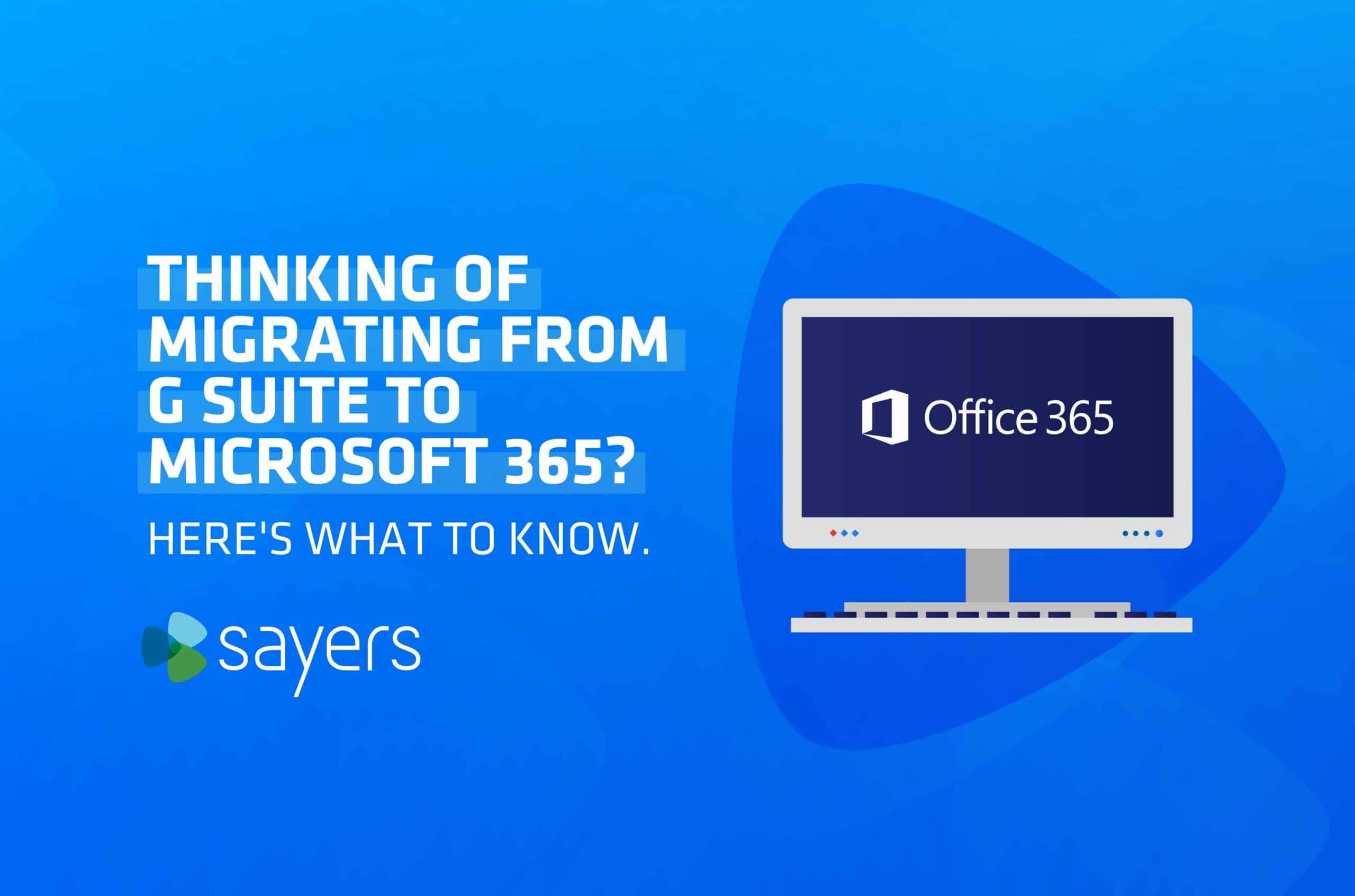Part of an organization’s cloud journey includes deciding which cloud-based software-as-a-service (SaaS) productivity suite will keep their business humming with email, collaboration tools, and apps for word processing, presentations, storage, and more.
G Suite, now known as Google Workspace, and Microsoft 365 (formerly Office 365) are the two leading cloud-based SaaS productivity suites for business. At Sayers we’re seeing more of our clients wanting to migrate to Microsoft 365, thanks to its security and compliance strengths, centralized administration, full feature-rich technology stack, wide range of pricing plans, and support of hybrid work models.
Microsoft 365 integrates with Microsoft’s other offerings including Azure and can scale on-demand as the organization grows.
What To Consider For Your G-Suite Migration to Microsoft 365
While every organization’s migration needs will vary, we’ve found the following pointers hold true for most businesses:
- Migration is more complex than you think. The two suites have some comparable elements, such as Google Drive and Microsoft’s OneDrive, “but it’s not a one-to-one migration,” says Bob Livingstone, Director of Cloud Engineering at Sayers. “There’s a fundamental difference between how things are organized and shared on the Google platform versus Microsoft.”
Microsoft does offer tools to perform a migration from Google Workspace, but there are several limitations and prerequisites to be aware of if your IT team attempts to perform it themselves. “It can be very complex to navigate effectively,” says Livingstone. “Each organization’s migration is unique and needs a custom plan that considers how the organization has used their Google platform, as well as how they intend to use their Microsoft platform going forward. It’s really an organization-by-organization approach.”
- Recognize the scale of migrations can be massive. A 1000-employee company can have hundreds of thousands of emails along with hundreds of thousands of files. “You’re talking about terabytes of data, and it keeps growing,” says Livingstone. “Every year a company is in the cloud, their data gets bigger. People use the data and applications more, they collaborate, they work remotely, and they can drop a file on their Google Drive or OneDrive right from their phone. These platforms make sharing files really easy, so the amount of data is exploding.”
- Your users need to understand what to expect. Functionality and capabilities of tools vary between the two platforms. An upfront communication plan should be part of your overall migration planning to prepare your users for the intended outcomes. Livingstone says:
“There are issues with every migration that go beyond just moving the bits. Successful projects are the ones that anticipate what problems are likely to occur, what questions users are going to ask, and then plan and communicate accordingly.”
- Prepare your IT support team. An effective communication plan not only prepares your users but also preps your IT support team for the types of questions they’re going to receive during and after the migration. At Sayers, we include the client’s IT support team as part of the migration planning so they are ready from day one to handle user calls and questions. “Anything the client’s IT support team isn’t sure about, we’re here to explain, validate it’s working as designed, or troubleshoot if there is an issue,” says Livingstone.
- Future-proof your data with the right architecture. Central to the migration is how to architect and use your data so it’s safely there for you in the future. Livingstone says this can be a big gotcha for companies who try to migrate from Google to Microsoft on their own, as in this real-life example:
“Before they came to us, a company had migrated themselves and used one employee’s Microsoft OneDrive to create directories and folder structures to share with the whole organization. People had started placing documents in there, then the person left the company and the user’s license got disabled. No one could access those shared folders and documents. The company hadn’t architected the platform properly, plus OneDrive wasn’t the right place for corporate-style shared documents that hundreds of people access.”
Another Successful G Suite Migration
Sayers recently provided migration services to a client company with more than 850 employees. The G Suite migration took just over two months from project kickoff to final migration. An email from the client company’s IT Director to the Sayers Senior Project Manager says, “Thanks for all the hard work from you and your team. I would like to give a shout-out to the Sayers team for all the great support and long hours they put in to make this project a success.”
——————
Questions? Contact us at Sayers today. We offer extensive solutions to cover all areas of your business.


